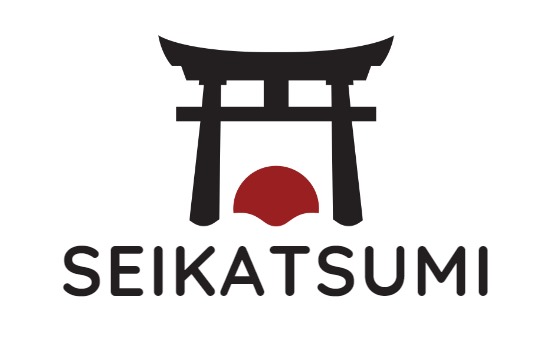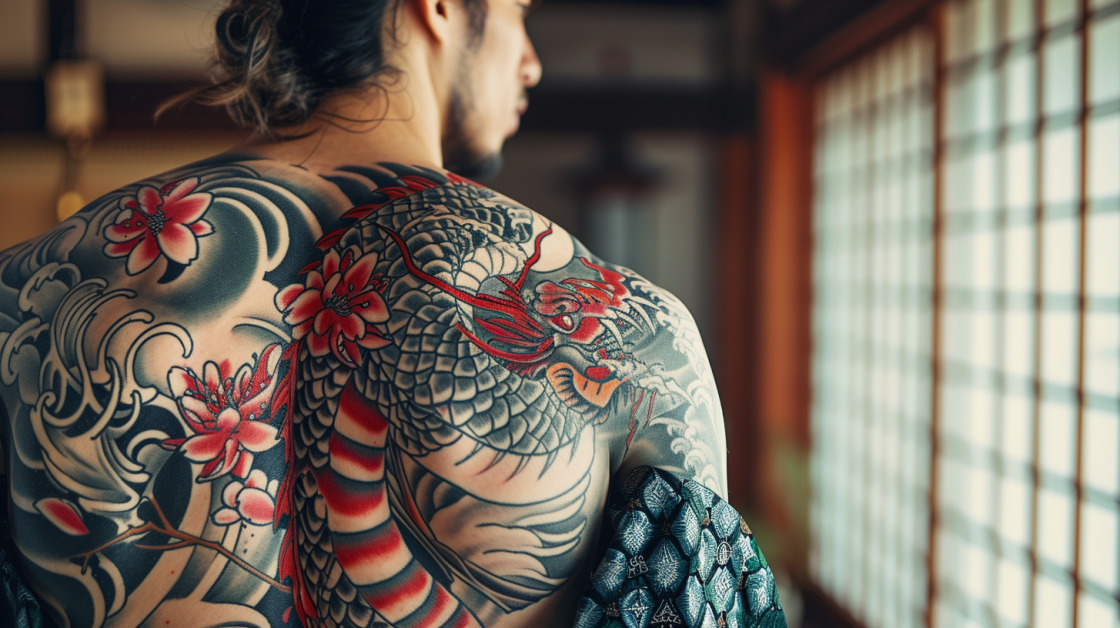Are you as captivated by the allure of Japanese back tattoos as I am? I’m absolutely thrilled to share this passion with you!
My fascination with Japanese culture has profoundly influenced my interest in Back Japanese Tattoos.
I understand that choosing to get a tattoo, especially one as significant as a full back piece, is a major decision.
That’s why I’ve dedicated time to researching everything from the rich history of Back Japanese Tattoos to current trends and expert techniques.
Join me in delving into the intricate world of Back Japanese Tattoos, where art meets personal expression in the most magnificent way. 😉
History of Back Japanese Tattoos
As a lover of tattoos, I have always been fascinated by the intricate designs and symbolism of Japanese tattoos.
Japanese tattoos, also known as Irezumi, have a long and rich history that dates back thousands of years.
Edo Period Origins
During the Edo period (1603-1868), Japanese tattoos became a popular form of body art among the working class. It is believed that the origins of Japanese tattoos can be traced back to the Ainu, the indigenous people of Japan.
The Ainu used tattoos to mark their status and for spiritual purposes. However, it was during the Edo period that Japanese tattoos became associated with criminality and were banned by the government.
Despite the ban, Back Japanese Tattoos continued to thrive underground. Tattoo artists, known as horishi, developed new techniques and styles, and their work became highly sought after.
Back Japanese Tattoos during this period often depicted mythological creatures, such as dragons and phoenixes, and were believed to have protective powers.
Modern Revival
In the 20th century, Japanese tattoos experienced a revival thanks to the work of tattoo artists such as Horiyoshi III and Shige.
These artists brought new life to traditional Japanese tattoo designs and techniques, and their work gained popularity both in Japan and abroad.
Today, Japanese tattoos continue to be a popular form of body art, with many people seeking out traditional designs and techniques.
Japanese tattoo artists are highly respected and often require extensive training and apprenticeships before they can practice on their own.
Symbolism in Japanese Tattoos
If you’re considering a Japanese tattoo, then you’re in for a treat!
Back Japanese Tattoos are rich in symbolism and meaning, and they have a long and storied history that dates back centuries.
Explore some of the most common symbols found in Japanese tattoos, including mythical creatures, floral motifs, and kanji characters:
Mythical Creatures
Mythical creatures are a staple of Japanese tattoos, and they are often depicted in bold, vibrant colors.
Some of the most popular mythical creatures found in Japanese tattoos include:
- Dragons: Japanese dragons are symbols of strength, wisdom, and good fortune. They are often depicted with long, serpentine bodies, fierce eyes, and sharp claws.
- Phoenixes: The phoenix is a symbol of rebirth and renewal. In Japanese mythology, the phoenix is said to rise from the ashes of its own destruction, making it a powerful symbol of resilience and strength.
- Koi Fish: Koi fish are often depicted in Japanese tattoos, and they are symbols of perseverance and determination. According to legend, a koi fish that is able to swim upstream and leap over the Dragon Gate will transform into a dragon, making it a powerful symbol of transformation and success.
Hey you! Are you interested in more tattoo trends? Then be sure to check out our top tattoo articles! You definitely can’t miss it!
Japanese Skull & Oni Mask Tattoos: 100+ Ideas You’ll Love 2024
The Best Japanese Half Sleeve Tattoos 2024: 25+ Be the next Trendsetter!
60+ Japanese Anime Tattoos: Expert Tips for Timeless Ink Mastery 2024
Floral Motifs
Floral motifs are also popular in Back Japanese Tattoos, and they are often used to represent different emotions and ideas.
Some of the most common floral motifs found in Japanese tattoos include:
- Cherry Blossoms: Cherry blossoms are a symbol of beauty, fragility, and the fleeting nature of life. They are often depicted in Back Japanese Tattoos as a reminder to appreciate the present moment and to live life to the fullest.
- Lotus Flowers: The lotus flower is a symbol of purity, enlightenment, and spiritual awakening. In Japanese tattoos, the lotus flower is often depicted as a reminder to stay true to oneself and to strive for inner peace and harmony.
- Peonies: Peonies are a symbol of wealth, prosperity, and good fortune. They are often depicted in Japanese tattoos as a reminder to stay focused on one’s goals and to work hard to achieve success.
Kanji Characters
Kanji characters are also commonly found in Japanese tattoos, and they are often used to represent different words and ideas.
Some of the most common kanji characters found in Back Japanese Tattoos include:
- Love: The kanji character for love is a popular choice for Japanese tattoos, and it is often used to represent romantic love, familial love, or love for oneself.
- Strength: The kanji character for strength is a powerful symbol of resilience and determination. It is often used in Japanese tattoos as a reminder to stay strong in the face of adversity.
- Courage: The kanji character for courage is a popular choice for Japanese tattoos, and it is often used to represent bravery, fearlessness, and a willingness to take risks.
Design and Aesthetics
As someone who is passionate about tattoos, I find Back Japanese Tattoos to be some of the most captivating and beautiful designs out there.
The intricate details and bold colors used in these tattoos make them truly unique and stunning pieces of art.
Irezumi Style
One of the defining features of Back Japanese Tattoos is the use of the Irezumi style. This style, which originated in Japan in the Edo period, is characterized by its use of bold lines and vibrant colors.
The designs often feature mythical creatures such as dragons, phoenixes, and tigers, as well as other elements of Japanese culture such as cherry blossoms and samurai warriors.
Color Usage
Color is an important element in Japanese back tattoos. Traditional colors used in these tattoos include black, red, and blue.
These colors are often used in combination with each other to create a striking contrast. The use of shading and gradients is also common in Back Japanese Tattoos, adding depth and dimension to the design.
Common Themes
There are several common themes found in Back Japanese Tattoos. One of the most popular themes is the koi fish, which is often depicted swimming upstream.
This design symbolizes perseverance and determination. Another popular theme is the cherry blossom, which represents the fleeting nature of life.
Dragons, which are often depicted as fierce and powerful creatures, are also a common theme in Back Japanese Tattoos.
Cultural Significance
As someone who has always been fascinated by Japanese culture, I find the history and cultural significance of back tattoos in Japan to be particularly intriguing.
Yakuza Association
The Yakuza, a Japanese criminal organization, has a strong association with tattoos. In fact, many members of the Yakuza have full-body tattoos that cover their backs, arms, and legs.
These tattoos, known as irezumi, are often intricate and highly detailed, featuring traditional Japanese designs such as dragons, koi fish, and cherry blossoms.
While the Yakuza is a criminal organization, their tattoos are still highly respected in Japan. This is because the art of tattooing has a long history in Japan, and irezumi is considered to be a form of art.
However, it is important to note that getting a tattoo in Japan is still somewhat taboo, and many public places such as hot springs and swimming pools prohibit people with tattoos from entering.
Social Perception
Outside of the Yakuza, back tattoos in Japan are viewed very differently. In fact, they are often associated with criminal activity and are seen as a sign of rebellion.
This negative perception of tattoos can be traced back to the Edo period, when tattoos were used to mark criminals and outcasts. Even today, many Japanese people view tattoos as a symbol of deviance and non-conformity.
However, there has been a recent shift in attitudes towards tattoos in Japan. Many young people are now getting tattoos as a form of self-expression, and some tattoo artists are even gaining mainstream recognition for their work.
Despite this, there is still a long way to go before tattoos are fully accepted in Japanese society.
Aftercare and Healing Process
Taking care of your new back Japanese tattoo is crucial to ensure it heals properly and looks its best. Aftercare begins as soon as your tattoo artist finishes their work.
They will bandage your tattoo, and you should leave it on for at least two hours. After removing the bandage, wash your tattoo with mild soap and warm water. Be gentle and avoid using a washcloth or anything abrasive.
It is recommended to soak your tattoo in hot water for 10-15 minutes after the first wash. This helps to reduce swelling and ease any discomfort.
You can repeat this process before bed and the next morning. Be sure to pat your tattoo dry with a paper towel and avoid rubbing it.
During the healing process, it’s important to keep your tattoo clean and moisturized. Use a fragrance-free, antibacterial soap to clean your tattoo and avoid moisturizers that contain alcohol or petroleum.
You can apply a thin layer of unscented lotion to your tattoo to keep it moisturized. Avoid exposing your tattoo to direct sunlight and swimming for the first few weeks.
In the first few days, your tattoo may ooze and be sore. This is normal and part of the healing process.
After a few days, your tattoo will start to scab and itch. Avoid picking at the scabs as this can lead to scarring and damage to your tattoo.
Remember, proper aftercare is crucial to ensure your back Japanese tattoo heals properly and looks its best.
Follow these simple steps to ensure your tattoo stays vibrant and beautiful for years to come.
My personal favorite back tattoo!
In my view, back Japanese tattoos featuring a samurai and dragon are among the most compelling and meaningful designs one can choose.
The samurai, a symbol of honor, discipline, and loyalty, paired with the dragon, emblematic of strength and wisdom, creates a powerful narrative on the canvas of the back.
I am particularly drawn to these motifs as they resonate deeply with my admiration for bravery and resilience. The back, with its expansive space, offers an ideal canvas to bring these intricate and symbolic designs to life in a grand and detailed manner.
Getting these images tattooed is not just about aesthetic appeal; it’s about embodying the values and stories they represent.
For me, these tattoos would be a profound personal statement, a permanent reflection of my favorite themes in Japanese lore, and a tribute to the rich cultural artistry of Japan.
Frequently asked Questions
What is a typical design for back Japanese tattoos?
Common designs include dragons, koi fish, samurai, and traditional Japanese scenes.
Do these tattoos have specific meanings?
Yes, they often symbolize strength, courage, and cultural stories or myths.
How large are back Japanese tattoos typically?
They can range from medium-sized pieces to full back ‘Irezumi’ covering the entire back.
If you liked this blog article about back japanese tattoos, don’t forget to follow us on Pinterest so you don’t miss any more tattoo tips.
Let us know, which of the above ist your favorite back tattoo!


